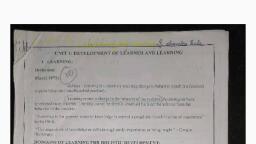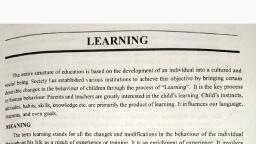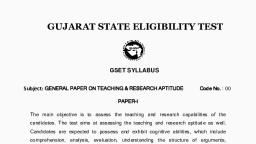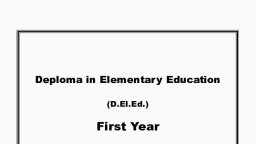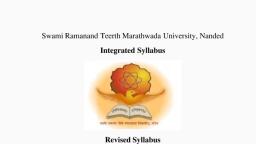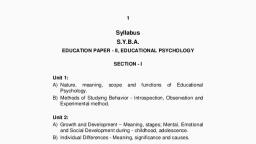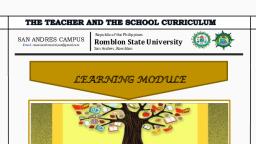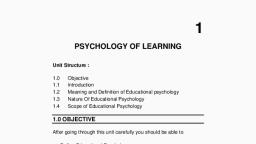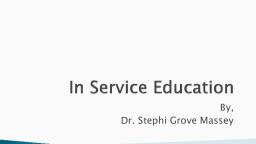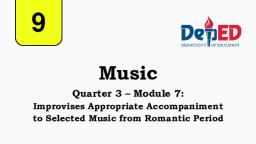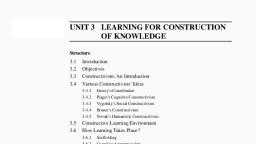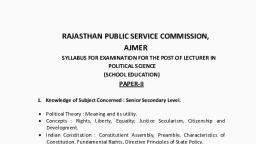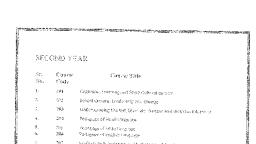Page 1 :
UNIT 1; DEVELOPMENT OF LEARNER AND LEARNING, , 1, LEARNING:, , Definition: 6, Marx( 1971) \, , Defines * Learning is a relatively enduring change in behavior which is a function, of prior behavior ( usually called practice),, , Learning means a change in the behavior of the students.)Psychologists have, developed many theories. Leariing cannot be directly observed bul it can be inferred from the, behavior of the students, , “Learning is the process whereby knowledge is created through the transformation of experience”, Kolb(1 984)., “The acquisition of knowledge or skills through study, experience, or being taught.” — Google, , Dictionary, DOMAINS OF LEARNING FOR HOLISTIC DEVELOPMENT:, x, , W There are three main domains of learning. These domains are cognitive (knowing /thinking),, affective (emotion/feeling), and psychomotor (doing/physical/kinesthetic), Each domain has a, arrangement sociated with it. All of the taxonomies are arranged so that they, , ‘om the simplest to more complex levels., , A. Cognitive Domain:, , The cognitive domain involves knowledge and the development of intellectual skills (Bloom, 1956)., This includes the recall or recogni s) dural patterns, and concepts that serve, in the development of intellectual abilities and skills.Xnowledge 2. Comprehension 3.Application 4. , Analysis 5. Synthesis 6. Evaluation, Krathwohl’s 001; Remembering, Understanding, Applying,, , B. Affective Domain:, , feGve ; i, Affective is concerne wohl), This taxonomy is, arranged from simpler fe more complex. Receiving, Responding, Valuing, Organization,, Characterization, , C. Psychomotor Domain:, The psychomotor domain includes physical movement, coordination, and use of the motor-skill, , areas. This taxonomy is arranged(Dave 1969) Imitation, Manipulation, Precision, Articulation,, Naturalization |, , PHASES OF LEARNING;, , | According to a classic psychological model of individual learning, before an individual acquire, SY Skill he/she come across following stages of leaming,Unconscious incompetence, Conscious, Mconazpetence, Conscious competence, Unconscious competencedn the classroom, Learning, process depends the following phases
Page 2 :
L, , ‘Apprehendi Genaraliza Feedback, n ee Retention Recall ‘an i [reinforce, , treanster! ment], , Motivation {attention, fexpectancr] ie selective:, , percertion), , [memory) (Retrieval), , ~-JNFLUENCE OF PEER GROUP, GROUP COHESION AND GROUP DYNAMI, ON LEARNING:, , Influence of peer group on learning:, , peer Bron!, A group of people of approximately the same age, status, and interests, , A peer group is both a social group and a primary group of people who have similar interests, (homophily), age, background, dr social status. The members of this group are likely to influence the, person’s beliefs and behaviour. Peer groups contain hierarchies and distinct patterns of behavior., , Influence of Group cohesion on learning:, Group cohesion:, , Cohesion can be more specifically defined as the tendency for a group to be in unity while, working towards a’goal or to satisfy the emotional needs of its members., , Group cohesion is a sense of togethemess, or community, within a group. A cohesive group is, one in which members have incentives for remaining in the group and share a f eling of, , belongings and relatedness., Influence of Group dynamics on learning:, Group dynamics:, , Dynamics comes from Greek word meaning FORCE. Thus, “Group dynamics i is concerned with, the interactions of forces among group members in a social situation.”, , It was founded by Kurt Lewin to study group decision, group productivity, group interaction,, group cohesiveness and group communication., , Group dynamics is a system of behaviors and psychological processes occurring within a, social group (intragroup dynamics), or between social groups (intergroup dynamics), , Good,C.V. Group dynamics implies an interactive psychological relationship in which members, of a group develop a common perception based on feeling and emotions, The inter-simulative, relationships may be described by the term group., , Kurt Lewin, a social psychologist, is credited with coining the term "group dynamics" in the, early 1940s. He noted that people often take on distinct roles and behaviors when they work in a, group. "Group dynamics” describes the effects of these roles and behaviors on other group members,, , and on the group as a whole. Groups may be open (permit the change of membership, allowing New, amember) or closed type (have stable membership)., , 2, , , , , , , , , , DEVEL,, , ENVIR), , th, , \BETWHE, , DS, , v, predictable ps
Page 3 :
\ DEVELOPMENT OF LEARNER AS A RESULTANT OF INTERACTIONS, [BETWEEN INDIVIDUAL POTENTIAL (INNATE, ACQUIRED) AND EXTERNAL, eV ENVIRONMENT, : We uit ‘{Hevelopment means a progressive series of ehangey that oceur in an orderly, predictable pattern as a result of maturation and experience”, , Individual potential innate, acquired):, , {A person's innate abilities are at the foundation of the learning process. These represent the, genetically determined abilities and limitations. i.e child possess inherited from his parents. Mozart, certainly possessed a greater innate musical capacity than other (innate), But most of others can, improve their musical ability with practice (acquired), Factors affecting Individual potential (Internal, Factors)Hereditary factors, Intelligence, Emotional factors, , External enyironment:)Factors influencing development, , Physical: A child's constitutional make-up, somatic or physical structure, body chemistry, , etc. influence his growth and development throughout his life., , Socio-cultural: Development is influenced by more than just the immediate environment of, , the family. Children grow up within a larger social community i.e the sociocultural context., , Ecological: Early behaviorist had defined environment as any and all external forces that, , shape the individual's development. Urie Bronfenbrenner used a concept from ecology to, , outline the interplay between the child and his/her immediate social and physical, , environment by microsystem, mesosystem, exo-system, macro-system and chronosystem, , Economie: Studi ow that children who live in impoverished areas have a harder time, , socializing than their more affluent peers., , Technological: The technological factor has immense influence in learning. Children rely, the majority of their play. Technology can be both beneficial and harmful, , to different ways in which learner., , NATURE AND NURTURE!, , The phrase nature and nurture relates to the relative importance of an individual's innate, qualities ("nature" in the sense of nativism or innatism) as compared to an individual's personal, Experiences ("nurture" in the sense of empiricism or behaviorism) in causing individual differences,, especially in behavioral saits., , Nature (Maturation)‘1s the orderly sequence of changes dictated by the child’s genetic blueprint., Nature refers to the child’s biological inheritance, nurture to environmental experiences., , Nurture (Environmental experience): it refers to all environmental influences after conception, and make them experienced. “f :, , 7. CONTINUITY AND DISCONTINUITY fy, , Continuity in development refers to gradual and cumulative changes in a child for example,, a child learns to crawl, and then to stand and then to walk, They are gradually learning how to walk., Psychologists who emphasize experience describe development as gradual and continuous., Comtinuity is human development like a seedling gradually growing into a giant oak., , Discontinuity in development refers to more distinctive and stage like changes in a child, {n, this view, each of us passes through a sequence of stages in which change is qualitative rather than., quantitative. i.e people pass through stages of life that are qualitatively different from each other
Page 4 :
a butterfly, As @ caterpilly, discontinuous., , , , Matt 7 tle y becomin, Discontinuity is human development li oa caterpillar suddenly oe acta, changes into a butter!ly. it becomes a different kind of organism. Its dev fF, , ; G, @GROWTH AND MATURATION: Eo tirpod Aree | eae, , , , * Itis the physical process of developmen, © tis quantifi, , ‘able, meaning that it can be measured, and it is mostly influenced by genetics ”, «this includes increases in the size of body parts, in weight and height, and in the number of, neural connections in the brain Wrordor wad a. threw Oe lope t, * growth is affected by environmental factors including hutrition. disease, shelter. rest., exposure to exercise and sunlight, and also psychological wellbeing, , , , , , , , , , , * physical growth ends at particular age, Example: a person getting physically taller and is quantifiable :, , Maturation, ® Ibis the physical, intellectual, or emotional process of development., , , , » Maturation is often not quantifiable and it too is mostly influenced by genetics, e changes that occur naturally and spontaneously and that are, to a large extent, genetically, programmed, © Wi&turational changes emerge over time and are relatively unaffected by environment, except, in cases of ma, / ¢ Maturation does not stop when physical growth ends - it continues through adulthood., d do before, , , , , , atrition or severe illness, , , , , , « Forexample, a person able to handle more complex tasks than he/she co, Holistic understanding of learner in context, , “Education witha holistic perspective 1s concemed with the development of every person's, | intellectual, emotional, social, physical, artis d spiritual potentials. It seeks to engage, ‘Students in the teaching/learning process and personal and collective responsibility., , , , , , The holistic education insists on the development of all the three domains namely Cognitive, he learners. The whole education system gives important through the, im of developing the holis viduals with the develo, nd state pattern of education, importance is, olastic and co scholastic aspect of the, , , , affect and psychomotor amor, | curriculum with the ultima, | the domains. At present under CBSC pattern, continuous and comprehensive evaluation, measuring, learner. Therefore, th f, , , , , ic ind, , , , , , , , teachers should understand the holistic aspect of the learner not only on the, above mentioned three domains but also on their innate and acquired individual potentials and, extemal environment of the learners. The externa! environment of the learners are decided based On, , , , cal, economic and technological environment, , , , their physical, socio- culture. ecolog, , Therefore, the holistic understanding of the learner is the very important one for the, teacher. This understanding will help the teacher for better class room man ent and also to be the, friernd, philosopher and guide of the learner., , , , Lea rner in context., , Learner in context refers to the student in particular level or particular class or for a particular, programme., , For example, ifa teacher is teaching the 9" standard student, the teacher must understandihe, , holistic understanding of the particular group student. If the teacher is teaching at the UKG el, teacher must understand the holistic aspect of the children in the class., , the, , , , , , , , , , , , 4, , Growth Plyrscad shrcetls | abe (optinee vlow, , Rive:, , , , , , , , , , , , , , NY Al DUAL CAMERA
Page 5 :
Lat \ \naprebicod, , , , , , , , , , , , , , , , , , , , , 2, = UNIT 2: THEORETICAL PERSPECTIVES ON LEARNING \\ | G| 20, ar! BENA ERSPECTIY, aa crspective>in which are described and, explained in terms offgtimulus- response relationships., fF The basic idea of behaviourism - learning consists of a clini in behaviour due to the acquisition., reinforcement and application of associations between stimuli from the environment and observable, responses of the individual ", The famous behaviorists treWohn Watson) lyan Pavlov's, Edward Thorndike and B.F, Skinner., C, 2.1.1 BEHAVIOURISM (CONDITIONING PARADIGM IN BRIEF), Conditioning means a significant influence on something (the manner or outcome of something).bring, (something) into the desired state for use. (synonyms: constrain. control, govern. determine, decide), . Gactt, Gwe The environment influences behavior >, Gp) Fe Learning is described through stimuli and responses 0 tt punts, Wied * Leaming must involve a beha’ hange 5 ge, * Learning must result when stimulus and response occur close together in time aie, , ¢ Animals and humans learn in similar way, , 2.1.2 JOHN WATSON - BEHAVIORISM:, , “John Broadus Watson (1879 to 1958) - American psychologist -(the father of school, of behaviorism) According to Watson, Behaviorism is the scientific study of human behavior. Its real goal is to, provide the basis for prediction and control of human beings to given the situation. Only behavior that could be, observed, recorded and measured was of any real value for the study of humans or animals, , "Give me a dozen healthy infants, well-formed, and my specified world to bring them up in and I'll, guarantee to take anyone at random and train him to becor cialist ] might select-doctor, lawyer,, t-chief, and ggar-man and thi of his talents, penchants, tendencies,, abilities, vocations, and race of his ancestors. 1 am going beyond my facts, and I admit it, but so have the, advocates to the contrary, and they have been doing so for many thousands of years." -John. B Watson., , , , artist, merchi, , , , , , , ejected the concept of the uncot us (Freudian concept) and the intemal, trospection) because it was not observable and was subject to the psychologists, , , , vioris!, , (, , Watson's bel, mental] state of a person, subjective aaa peesetion, , , , , , 2.1.31VAN PAVLOV’ 'S CLASSICAL, CONDITIONIN!, , , , Tvan Pavlov (1849-1936)- Russian scientist observed the dogs was that drooling had a much more, far-reaching effect than he ever thought: it paved the way for a new theory about behavior and a new way to, , study humans. —, , : " : Le >, Classical Conditioning ) q, =" There’s a non-neutral or unconditioned stimulus (the food), which will produce an unconditioned, response (salivation). There's also a neutral stimulus (the bell), which by itself will not produce a response,, like salivation, But if we present the neutral stimulus and the unconditioned stimulus together, eventually the, dog will learn to associate the two. Afier a while, the neutral stimulus by itself will produce the same, , response as the unconditioned stimulus, like the dogs salivating when they heard the bell., , , , , , Ano, node, nie 1 ., ee hy Now:

